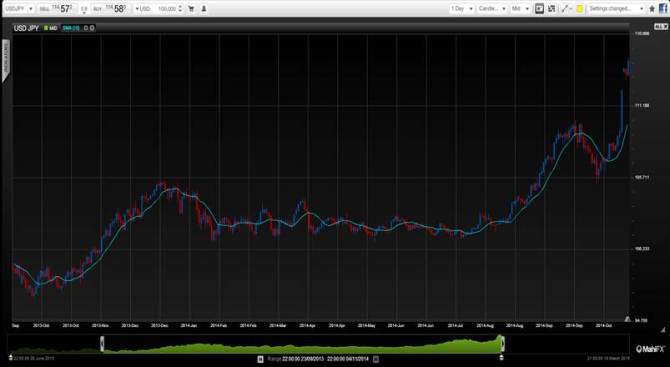Last week could well set the tone for the forex markets into next year with a very definite divide opening up between the monetary policies of the various major central banks. Divergence in monetary policy spells the long trends in forex markets beloved by traders.
The most extreme divergence among the major central banks is between the US and Japan – potentially setting a long bull run for USD/JPY, possibly all the way to 125, if not beyond.
The US Federal Reserve ended its quantitative easing programme as expected adding that interest rates will remain where they are for a ‘considerable’ time. A Republican dominated Senate following the mid-term elections could see the Fed under pressure to tighten monetary policy more quickly. A move towards a gradually tighter US monetary policy should be enough to sustain the USD rally.
Over in Japan it is the exact opposite story. The Bank of Japan’s actions frankly look disturbing and desperate as it is embarking on the biggest quantitative easing programme ever seen. The BoJ is raising its asset purchases from JPY 60tn-70tn a year to JPY 80tn ($700bn) and these include some equities. At the same time the giant Government Pension Investment Fund with over $1tn in holdings is to increase equity holdings to 50% from 24% and reduce domestic bonds to 35% from 60%.
By Justin Pugsley, Markets Analyst. MahiFX Follow @MahiFX on twitter
So while the BoJ is stuffing itself with JGBs, the GPIF is going to be scaling back and moving more funds abroad – leaving very little reason to be optimistic about JPY or even Japan itself.
USD/JPY – where does it end?
Slow death of JPY
Increasing the BoJ’s QE programme will not sustainably reinvigorate growth. Japan has a rapidly ageing population and one that overall is set to shrink. The only way left to create sustainable growth is via big advances in productivity (very difficult for a mature economy) or to allow large scale immigration (politically contentious) to boost the population and the number of workers and consumers.
Spurring exports through a weaker JPY will only have a limited impact as international trade accounts for a relatively small proportion of the economy. And Japan’s policy makers must know this. If begs the question as to whether the real reason for the BoJ’s bond purchases is to simply fund the government itself – a move that tends to end very badly.
The Eurozone is somewhere in between the US and Japan. The European Central Bank is looking at every way possible to pump cash into the struggling region, short of doing outright QE by buying government bonds in the secondary markets. The idea of purchasing different types of corporate debt and extending loans to banks is likely to be a slow process – particularly if demand for credit is not that strong from the private sector.
The Bank of England is much closer to the Fed in its monetary policy. But the UK has more exposure to international trade than the US and Japan. It is vulnerable to events in the Eurozone (particularly for exports) and already has a very large current account deficit as domestic growth is sucking in imports.
If global economic growth does slow next year as some forecasters have suggested, then concerns over the Eurozone could once again be raised and those discussions could include Japan as well.

